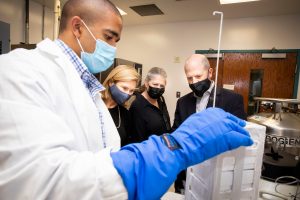Fellowship Gift
September 30, 2021 | Leigh MacMillan
After about a decade of treatment for the blood cancer polycythemia vera (PV), Paula Lovell’s bad days started outnumbering the good ones. She told her doctor, Michael Savona, MD, that she was “having one of my spells,” a phrase that her grandmother had used when an occasional sickness wasn’t easily explained.
“I had no good way to describe it; I was so fatigued that I almost couldn’t get out of bed for a few days at a time,” Lovell says. “Dr. Savona asked me to keep a diary. He was determined to figure out what these ‘spells’ were. I was so impressed with his attention to all of my side effects and that he didn’t just say, ‘Well, that’s part of PV.’”
PV is the most common of the “myeloproliferative neoplasms” (MPNs) in which the body produces too many blood cells. The uncontrolled blood production, especially of red blood cells, results from an acquired mutation in a hematopoietic stem cell (a cell that can divide to form all the types of blood cells).
Almost all patients with PV, including Lovell, have a mutation in the JAK2 gene in their blood cells, which encodes a cellular signaling protein.

Donovan Brown, the first Lovell Family Fellow, performs an experiment, as (left to right) Paula Lovell, Beth Lovell Williamson and Michael Savona, MD, observe. Photo by Susan Urmy.
Extra red blood cells make the blood thicker than normal, and the mutations that drive MPNs make the endothelium (the blood vessel lining) “angry” and the blood cells “stickier,” says Savona, professor of Medicine and holder of the Beverly and George Rawlings Directorship. “Patients with MPNs have these mutations in blood cells that cause inflammation, and they have considerable risk of blood clots” that could cause heart attacks or strokes.
For years, Lovell was treated with the cytotoxic chemotherapy hydroxyurea to slow blood cell growth and with periodic therapeutic phlebotomies to remove blood cells. Blood draws were always problematic though, because Lovell had been treated for breast cancer when she was in her 50s. The removal of lymph nodes on her left side meant that blood draws were limited to her right arm, where the veins were mostly collapsed from chemotherapy.
“It was getting harder and harder, and I was having to have more and more phlebotomies to keep my hematocrit in line, and the higher doses of hydroxyurea were intolerable,” Lovell said.
Savona suggested she change treatments to a drug called ruxolitinib, a targeted therapy that inhibits JAK2 and the related signaling protein JAK1. Lovell began taking ruxolitinib early this year and has not experienced major side effects or needed therapeutic phlebotomies.
“I’m almost 70 years old, and I feel like I’m 40,” she says.
Lovell was a journalist for 10 years before founding Lovell Communications, a national health care PR and crisis communications firm, in 1988. At her appointments with Savona, she started asking questions about his research. They were both intrigued by her family’s experience with blood cancers. Her mother was diagnosed with PV a few years ago and was successfully treated with hydroxyurea. (Her mother had the same JAK2 mutation.) Lovell’s father went through aggressive treatment for acute myeloid leukemia when he was in his 50s. Her parents passed away from other causes.
Lovell was eager to support Savona’s research, and her sister, Beth Williamson, enthusiastically joined her to establish the Lovell Family Fellow Fund to support physicians and scientists, and additionally an endowment to provide funding in perpetuity for blood cancer discovery.
Williamson saw firsthand the power of research to change patient care when she was treated six years after her sister for the same type of breast cancer with very similar clinical characteristics.
“My treatment was different from Paula’s, because the research had changed so much,” Williamson says. “It’s amazing what scientists can learn in just six years. I would like to see them make the same kind of progress with PV and other blood cancers.”
Donovan Brown, who graduated from Penn State this year, has joined Savona’s group as the first Lovell Family Fellow. Brown is studying human hematopoietic stem cells engineered with JAK2 mutations. The team has developed methods to watch the cells as they grow in a bone marrow model, to learn how the mutation affects cell growth and to evaluate the effect of blocking the mutation. Brown plans to enter an MD-PhD program after the two-year fellowship.
“I feel like I’m part of the research, and I’m excited that they will be learning about the JAK2 mutation that I have in my body,” Lovell says. “I hope they will find new ways to treat blood cancers that improve the lives of people suffering from these diseases.”
Williamson and Lovell consider the endowment a recognition of their parents.
“Our mother and father were remarkable human beings, and it feels really good to honor them in this way,” Williamson says. “I think they would approve.”
